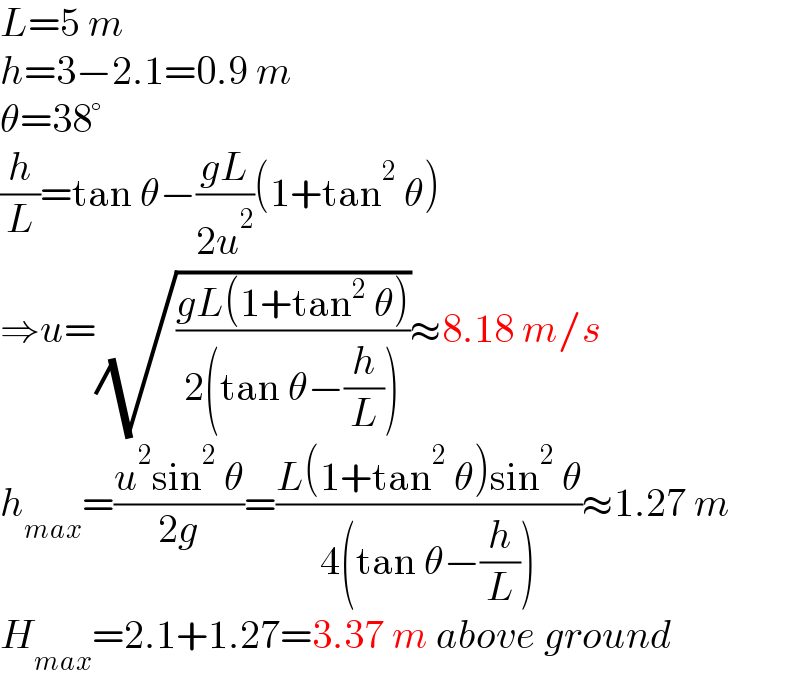
Question Number 135618 by physicstutes last updated on 14/Mar/21

$$\:\mathrm{At}\:\mathrm{what}\:\mathrm{speed}\:\mathrm{should}\:\mathrm{a}\:\mathrm{basket}\:\mathrm{ball}\:\mathrm{player}\:\mathrm{project}\:\mathrm{a}\:\mathrm{ball}\:\mathrm{from}\:\mathrm{a}\:\mathrm{height} \\ $$$$\mathrm{of}\:\mathrm{2}.\mathrm{1}\:\mathrm{m} \\ $$$$\mathrm{above}\:\mathrm{the}\:\mathrm{ground}\:\mathrm{at}\:\mathrm{an}\:\mathrm{angle}\:\mathrm{of}\:\mathrm{38}° \\ $$$$\mathrm{to}\:\mathrm{the}\:\mathrm{horizontal}\:\mathrm{so}\:\mathrm{that}\:\mathrm{it}\:\mathrm{just}\:\mathrm{passes}\:\mathrm{through}\:\mathrm{a}\:\mathrm{basket}\:\mathrm{ball}\:\mathrm{net}\:\mathrm{which} \\ $$$$\mathrm{is}\:\mathrm{at}\:\mathrm{a}\:\mathrm{horizontal}\:\mathrm{distance}\:\mathrm{of}\:\mathrm{5}\:\mathrm{m}\:\mathrm{from}\:\mathrm{the}\:\mathrm{initial} \\ $$$$\mathrm{position}\:\mathrm{of}\:\mathrm{the}\:\mathrm{ball}\:\mathrm{and}\:\mathrm{3}\:\mathrm{m}\:\mathrm{above}\:\mathrm{the}\:\mathrm{playground}.\:\mathrm{at}\:\mathrm{determine}\:\mathrm{the}\:\mathrm{balls} \\ $$$$\mathrm{maximum}\:\mathrm{height}\:\mathrm{above}\:\mathrm{the}\:\mathrm{ground}. \\ $$
Answered by mr W last updated on 14/Mar/21

$${L}=\mathrm{5}\:{m} \\ $$$${h}=\mathrm{3}−\mathrm{2}.\mathrm{1}=\mathrm{0}.\mathrm{9}\:{m} \\ $$$$\theta=\mathrm{38}° \\ $$$$\frac{{h}}{{L}}=\mathrm{tan}\:\theta−\frac{{gL}}{\mathrm{2}{u}^{\mathrm{2}} }\left(\mathrm{1}+\mathrm{tan}^{\mathrm{2}} \:\theta\right) \\ $$$$\Rightarrow{u}=\sqrt{\frac{{gL}\left(\mathrm{1}+\mathrm{tan}^{\mathrm{2}} \:\theta\right)}{\mathrm{2}\left(\mathrm{tan}\:\theta−\frac{{h}}{{L}}\right)}}\approx\mathrm{8}.\mathrm{18}\:{m}/{s} \\ $$$${h}_{{max}} =\frac{{u}^{\mathrm{2}} \mathrm{sin}^{\mathrm{2}} \:\theta}{\mathrm{2}{g}}=\frac{{L}\left(\mathrm{1}+\mathrm{tan}^{\mathrm{2}} \:\theta\right)\mathrm{sin}^{\mathrm{2}} \:\theta}{\mathrm{4}\left(\mathrm{tan}\:\theta−\frac{{h}}{{L}}\right)}\approx\mathrm{1}.\mathrm{27}\:{m} \\ $$$${H}_{{max}} =\mathrm{2}.\mathrm{1}+\mathrm{1}.\mathrm{27}=\mathrm{3}.\mathrm{37}\:{m}\:{above}\:{ground} \\ $$
Commented by physicstutes last updated on 14/Mar/21

$$\mathrm{perfect}\:\mathrm{sir} \\ $$
Commented by mr W last updated on 14/Mar/21

